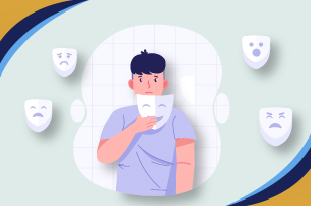It’s time to discover the power of mental health awareness color, be it the green ribbons or the related global campaigns, you will learn how color as an identifiable symbol impacts someone’s well-being.
Mental Health Awareness Colors
The color such as green holds considerable value and is prominent as a representative color. Specific colors are important for playing a significant role in raising awareness and fostering conversations about mental health. We’ll be delving into the prominence of the color green and the influence this color has on mental health.
Mental Health Awareness Color and Its Impact
Significance of Green
For mental health awareness, green is the designated color. For symbolizing new life, renewal, and growth that is often found in nature, green is chosen! It is representative of the idea of how affected individuals can recover, heal, and personally grow from mental health challenges that are faced by them. The shade of green can range from light green to the one where it has a yellowish hue when it comes to the Mental Health Flag. These shades also signify a personal journey of recovery from darkness to happiness, often consisting of efforts that shed light on the topic of mental health.
Through international association with mental health awareness, especially awareness about depression, the green ribbon displays the support and encouragement to foster dialogue about the said illness, specifically aiming to eliminate the stigma that surrounds it (Leora. B.H. Staff, 2024). It is also a visual reminder that essentially prioritizes mental health and seeks to foster a more empathetic and supportive society.
Read More: Coping Mechanisms For Depression: Practical Strategies To Help You Navigate
Influence of Color on Mental Health
The emotions and the well-being of individuals affected with mental health problems are profoundly and positively impacted by the colors associated with mental health awareness. Comparable to nature, the color green is especially associated with a refreshing and calming effect. It is meant to induce relaxation and stress relief, which is why it is often seen in mental health wards of hospitals and related waiting rooms. It is also capable of creating an atmosphere of tranquility and formulates a direct connection between nature and the natural world, in the process becoming beneficial for affected individuals essentially signifying
Color has a profound impact on our emotions and well-being. The color green, associated with nature, has a calming and refreshing effect. It is often used in spaces where relaxation and stress relief are important, such as hospitals and waiting rooms. The presence of green can create a sense of tranquility and connection to the natural world, which can be beneficial for individuals experiencing mental health challenges (Leora. B.H. Staff, 2024).
The green color tends to promote balance, harmony, and in its truest sense, renewal while creating a balance between them when it comes to color psychology. Experts believe that it reduces anxiety, promotes relaxation, and fosters a sense of hopefulness and an opportunity for an optimistic future, thus creating a positive influence on mental health.
The usage of color green in different mental health initiatives, awareness efforts, and campaigns, brings about an environment that is open to discourse, empathy, and a supportive foundation for affected individuals. For example, wearing green or adorning buildings with green lights during the mental health month visually represents solidarity and support for the aforementioned mental health awareness initiatives that are keen on raising awareness and reducing the stigma that surrounds mental health.
Once you understand the significance of the color green, it allows you to recognize the significance of prioritizing mental health, so a more compassionate society can be fostered that promotes dialogues on contribution to overall well-being.

Mental Health Awareness Ribbons
Ribbons are often used as tools that symbolize the support and awareness of different causes. The red color for a physical issue like AIDs is a prominent example and mental health is another example. We’ll be exploring what essentially these ribbons symbolize (specifically when made as a mental health awareness color), especially when it comes to the symbolism of green ribbons in the mental health awareness context.
Read More: ADHD vs Depression: Finding The Link Between Them
Green Ribbon Symbolism
People often ask why is green the color for mental health? Internationally recognized as a symbol of mental health awareness, the green ribbon represents how one is committing to understanding and providing support for affected individuals. If you see someone wearing the green ribbon, they are essentially displaying their support and solidarity for people suffering from mental issues and advocacy that fosters conversations about mental health, so the stigma surrounding it can be reduced (Fundraising For A Cause, n.d.)
Green, which is often linked to nature, symbolizes new life, renewal, and growth. In the context of mental health and similar to this, the green ribbon signifies that it is essential to support and understand those who are negatively impacted by mental health challenges as they can experience recovery, healing, and personal growth. It reminds us that understanding and supporting affected individuals is important to focus on instead of stigmatizing it (Pathakji, 2023).
The green ribbon is also meant to signify depression awareness as it encourages open conversations about depression and focuses on reducing the stigma that encompasses mental health conditions. If you wear the green ribbon, many people will come to you and recognize that support. Individuals who show support, also do so for their loved ones, who might be affected by issues such as depression and they may even remember those who were lost to the illness (Leora B.H. Staff, 2024). With these answers you won’t have to answer questions like “What color represents mental health?”, or “Why is green the color for mental health?”.
Light Green Ribbons
The ribbons with the lighter hue of green also hold a lot of significance when it comes to the realm of mental health awareness. This color is often associated with particular mental health conditions such as bipolar disorder or childhood depression, where individuals can raise voices for those who are affected by these specific mental health problems.
The use of ribbons in mental health advocacy and awareness campaigns is representative of understanding, empathy, and support for affected individuals. It reminds us to prioritize conversations about mental wellness and motivates us to create environments that are keen on fostering acceptance and compassion.
We have to understand the symbolism behind the green ribbon and light green ribbons, as these ribbons allow people to actively participate in mental health awareness initiatives and contribute to reducing the stigma surrounding mental health conditions. People can spark conversations, raise awareness, and demonstrate their support for mental health advocacy just by wearing these ribbons.
Read More: Is Major Depressive Disorder The Same As Bipolar Disorder?
Mental Health Awareness Color Campaigns
Raising awareness about mental health is paramount to the promotion of understanding, reduction of stigma, and the process that encourages support for individuals facing mental health challenges. Various campaigns (often associated with a mental health color) dedicated to mental health awareness are in existence, two of these namely are National Minority Mental Health Month and Mental Health Month Initiatives. All of these initiatives are important for shedding light on mental health issues such as anxiety disorders like OCD and neurodevelopment conditions like ADHD.
National Minority Mental Health Month
Observed each July in the United States, National Minority Mental Health Month aims to raise awareness about the issues that exacerbate the fault lines of the mental health of racial and ethnic minority groups. The aim is to strive to address disparities and improve mental health outcomes among these groups in the process. In doing so, it also shines a light on the unique experiences and needs of minority communities as this campaign strives to foster understanding and support for mental health awareness among them.
Mental Health Month Initiatives
Observed in May, Mental Health Month is essentially dedicated to raising awareness and reducing the stigma surrounding mental health (especially when making use of mental health color ribbons). It focuses on promoting mental health education, advocacy, and support to create a supportive environment that is keen on promoting mental wellness for all. This campaign aims to encourage open conversations about mental health, provide resources, and support individuals in seeking help when needed.
These campaigns strive to destigmatize mental health issues and promote understanding and support within communities. By dedicating particular months to mental health awareness, these initiatives are capable of creating opportunities for education, dialogue, and actions that improve mental health. It is through these collective efforts that we are able to work towards a society that gives vital importance to mental wellness while offering support to those in need.
Read More: The Hidden Mental Scars of Childhood Trauma in Adults
Impact of Color on Wellness Relating to Mental Health
There is a whole field of color therapy, also known as chromotherapy, in existence as colors have a profound impact on our emotions and well-being. This suggests that different colors on the visible light spectrum have unique wavelengths and vibrations that can affect our mental health (Nicola, 2024). Understanding these colors and their benefits are key to color therapy as color psychology can provide insights into how colors can positively influence our mental wellness.

Color Therapy Benefits
Color therapy accrues a range of different benefits for mental health. Research on the effectiveness of color therapy is still emerging and anecdotal. Even then evidence suggests that it can play a role in improving mental well-being. Here are some potential benefits associated with specific colors, which will help you understand the benefits of a mental health awareness color:
Blue: Blue signifies a calming effect. Therefore it can help reduce anxiety and stress. It promotes relaxation and tranquility, contributing to an overall sense of wellness.
Green: Considered to be a symbol of growth, renewal, and harmony, it is often associated with feelings of balance and can have a soothing effect on the mind. Green is also meant to be used to create a sense of calmness and relaxation.
Yellow: Known for its energizing and uplifting qualities, yellow is capable of enhancing mood, promoting feelings of happiness and optimism, and stimulating mental activity.
Purple: Purple is often associated with spirituality and creativity. It is believed to have a calming effect on the mind and can promote a sense of inner peace and tranquility.
Red: Red is vibrant and stimulating. As a result, it is able to easily increase heart rate and signal alertness or excitement. Often associated with passion, it can evoke feelings of energy and motivation.
Read More: Can Anxiety Disorder Cause High Blood Pressure? Insights About The Connection
Individual responses to colors tend to vary, but still integrating these calming colors into personal spaces or attire can bring tranquility and benefits for mental health. Research backs up the claim that environments adorned with serene colors foster a peaceful mindset and improve mental health considerably. In addition to that, exposure to vibrant colors, especially during darker months, can improve mood and mental health by elevating dopamine levels and mimicking the essence of sunlight, counteracting the negative effects of disorders such as Seasonal Affective Disorder (SAD).
Color Psychology in Mental Health
Researchers believe that different colors can trigger physiological responses and they are capable of evoking specific emotional states due to that. Color psychology explores how colors can impact our emotions, behaviors, and mental wellness and we can use that for our benefit (Office of the Surgeon General (US) et al., 2001). Below are some of the common associations found between colors and their effects on mental health which are also represented as a mental health ribbon color:
Red: Red is the color of passion, energy, and excitement. As mentioned before, it can increase heart rate and stimulate the mind, making it beneficial for tasks that require alertness and focus. However, excessive exposure to red often leads to feelings of restlessness or agitation. It is often associated with substance abuse recovery and prevention.
Blue: Blue is known for its calming and soothing qualities. It can promote relaxation and reduce anxiety and stress, which is the reason it is often used in therapeutic environments to create a sense of tranquility and mental wellness. There is a periwinkle one which is kind of blue color and it focuses on eating disorders as a mental health awareness color when put on a ribbon while the light blue one is linked to men’s health.
Yellow: Yellow is associated with happiness, optimism, and mental stimulation as it invokes feelings of joy and positivity. It is often used to uplift moods and enhance mental alertness. As mental health awareness color it is also associated with suicide prevention.
Green: We are reiterating that green is linked to feelings of balance, harmony, and renewal. It is often associated with nature and can have a calming effect on the mind. Green is capable of promoting a sense of balanced mental wellness and emotional stability. As mentioned before, green is often associated with depression and mental health awareness generally.
Analyzing the impact of colors on mental health can help us navigate the realms of mental health issues and help create environments that foster positive emotions and overall well-being. Incorporating calming colors into our surroundings, say through painting your home or your clothes, can contribute to peace and enhance mental health significantly. While color therapy and color psychology are not standalone solutions for mental health challenges, they can be valuable tools to support overall wellness and complement professional care.
Read More: What’s The Difference Between A Mood Disorder And A Personality Disorder?
Cultural Diversity in Mental Health
Mental health factors in various cultural variables that shape the perceptions, experiences, and attitudes towards mental health and illness. These variables impact mental health (especially when combined) and can include beliefs, values, customs, and social norms. Understanding these cultural factors is important for providing effective and culturally sensitive mental health care.
Cultural Impacts on Mental Health
Different cultural groups have unique ways of understanding and interpreting mental health and illness, which is why we shouldn’t undermine the belief that cultural diversity has a profound impact on mental health. Mental health can shape how individuals perceive and express their distress, as well as influence help-seeking behaviors via cultural beliefs and practices that surround them. For example, in some cultures, mental health issues may be attributed to spiritual or supernatural causes like when they used to consider women who had mental health issues as witches during the older times, while in others, they may be seen as a result of personal weaknesses or moral failings.
Moreover, historical trauma, intergenerational trauma, and experiences of racism and discrimination also play their part in forming bad or good mental health of individuals from diverse cultural backgrounds. For instance, First Nations People, African-American communities, and Latino communities in the US may face additional barriers to accessing mental health services due to mistrust of clinicians, historical persecution, and current issues of racism and discrimination, and that directly plays a part in whether they are going to receive treatment such as psychotherapy or not adding to their plight and decreasing the chances of their recovery considerably.
The stigma around mental health should not be underestimated as it is associated with mental health as a common challenge across cultures. Stigma refers to negative attitudes and beliefs that lead to fear, rejection, avoidance, and discrimination against individuals with mental illness. Stigma often motivates affected individuals to hide their symptoms due to feelings of shame and fear of discrimination. It can also lead to social alienation, loss of access to services, and inadequate interventions. Overcoming stigma is critical to the promotion of mental health and the only way to help ensure that individuals from diverse cultural backgrounds receive the support they need.
Read More: What is the Purpose of the Eating Disorder Symbol?
Stigma and Mental Health Care
Delayed treatment-seeking and acute-stage presentations are often the result of this stigma as it poses a significant barrier for individuals from diverse cultures to seek mental health care. Stigma may arise from cultural misunderstandings, stereotypes, and fear of judgment or discrimination. Individuals may hesitate to disclose their mental health concerns due to concerns about the potential impact on their personal relationships, community standing, or employment opportunities.

To address stigma and improve mental health care for culturally diverse populations, it is essential to promote awareness, education, and cultural competence among mental health professionals. Culturally sensitive approaches that recognize and respect the diversity of beliefs, values, and practices are vital. Creating safe and inclusive environments where individuals feel understood and supported can help reduce stigma and encourage help-seeking behavior.
We have to work towards a more inclusive and effective mental health care system that meets the needs of individuals from diverse cultural backgrounds by acknowledging and understanding the cultural impacts on mental health and addressing the inherent stigma attached to it. This is why it is crucial to continue advocating for mental health awareness and promoting culturally sensitive practices to ensure equitable access to quality mental health care for all individuals, regardless of their cultural background.
Read More: Do You Ever Wonder That Your OCD Thoughts Are Not Real?
Global Mental Health Insights
In this section, we will explore the prevalence of mental health disorders worldwide and discuss the importance of addressing stigma in mental health as understanding the global landscape of mental health is critical to addressing the challenges associated with mental health disorders and the stigma surrounding them.
Prevalence of Disorders Worldwide
Because the prevalence of specific disorders remains relatively consistent across different regions, mental health disorders are a global concern that affects people regardless of their cultural or geographical backgrounds. You can attest to that after realizing that schizophrenia has a similar prevalence of around 1% of the population worldwide, while bipolar disorder and panic disorder also have relatively consistent lifetime prevalence rates ranging from 0.3% to 1.5% and 0.4% to 2.9%, respectively. These disorders have a high heritability, indicating that culture and societal factors play a more subordinate role in their causation. One thing to note is that a mental health awareness color on a ribbon can create awareness for it.
It is also important to note that the rates of mental health disorders can vary across countries and ethnic subgroups. Suicide rates are quintessential showing of significant divergence among different populations. In the United States alone suicide rates among males are highest for American Indians and Alaskan Natives, while comparatively rates are lowest for African American women. The reasons for these variations are influenced by social and cultural contexts specific to each subgroup.
Cultural and social factors also play a significant role in the causation of certain mental health disorders. Post-traumatic stress disorder (PTSD), for example, is strongly influenced by traumatic experiences. Communities with a high degree of pre-immigration exposure to trauma and individuals in high-risk environments, such as combat veterans, inner-city residents, and immigrants from countries in turmoil, often experience higher rates of PTSD.
Read More: Adjustment disorder vs PTSD : Similarities and Differences
Addressing Stigma in Mental Health
Stigma is a formidable obstacle to progress in the field of mental health. It encompasses a cluster of negative attitudes and beliefs that lead to fear, rejection, avoidance, and discrimination against people with mental illness. Stigma is prevalent not only in the United States and other Western nations but also in Asian countries. Its impact on individuals with mental illness can be profound, leading to diminished self-esteem, increased isolation, and a sense of hopelessness.
To address and overcome stigma, it is crucial to raise mental health awareness and promote understanding of mental health issues. Education and public campaigns play a vital role in dispelling misconceptions and fostering empathy towards individuals with mental health disorders. By sharing mental health awareness quotes and promoting open conversations, we can challenge the negative stereotypes associated with mental illness.
Additionally, community support and access to mental health services are essential in reducing stigma and providing individuals with the care they need. Efforts to integrate mental health care into primary healthcare systems, increase mental health literacy, and train healthcare professionals to address mental health concerns can contribute to combating stigma and improving overall mental health outcomes.
Read More: Understanding The Fawn Trauma Response: What It Is And How It Impacts Us?
Recognizing the prevalence of mental health disorders worldwide and actively working to address stigma should be the foremost goal. This way we can create a more inclusive and supportive environment for individuals with mental illness. This way we can also foster a global community that understands, accepts, and supports the mental wellness of all individuals.
Conclusion
We have discussed the positive impact of mental health awareness color and deeply related terms and concepts to help you understand the importance of color for mental health awareness. Making treatment easier is also an awareness goal that you can make use of by seeking it at Orange Coast Psychiatry through treatment methods like psychiatric medication management or something alternative such as telehealth psychiatry. Looking forward to your appointment.
























